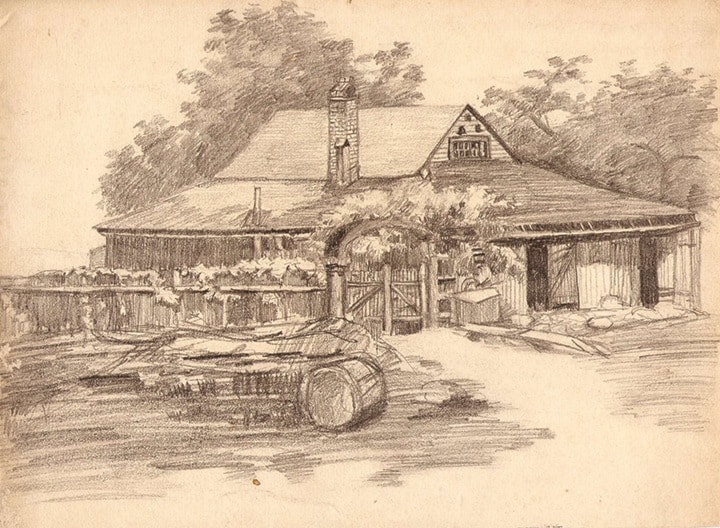When he married 22 year-old Lilette Rebbeck on April 26, 1911, Edward Mahon was nearing 50. Her father was a friend and business associate, and as he was dying of cancer the previous summer, he asked Edward to look after his wife Elizabeth and their three children. He was hoping Edward would marry his widow, but Edward chose the eldest daughter instead. He relocated the family to his Capilano Suspension Bridge property and hired Elizabeth as manageress.
The young lady was already a talented artist, having been taught sketching and painting by Emily Carr. Several Victoria mothers begged Emily to offer their children art classes, and 10 year-old Lilette was one of the lucky ones. Her accomplishments during that magical time survive, and bear witness to a remarkable talent in one so young.
Even more touching are her reminiscences of what must have been the highlight of her childhood. Her description of Emily shows that she was also a sensitive observer and a talented writer.
“We called her Milly. She was a gay and exciting person. Eyes sometimes grey green, sometimes blue grey, thick stubby lashes shading their twinkle, an elusive dimple, piled up brown curls tamed into a bun on top of her head; neat poulter pigeon figure, rare flashes of authority when we became too exuberant. A merry and amusing creature not far removed from ourselves.”
 LEFT: Lilette Rebbeck, as she was when Edward first started to court her. As president of the Vancouver Club, he had invited her to the 1908 New Year’s Eve Ball. (Courtesy of Mahon Family Records)
LEFT: Lilette Rebbeck, as she was when Edward first started to court her. As president of the Vancouver Club, he had invited her to the 1908 New Year’s Eve Ball. (Courtesy of Mahon Family Records)
Emily sought out new ways of artistic expression and was not afraid of experimentation:
“We drew from models, which was most unusual in that day — Emily Carr was always well ahead of her time. She hadn’t any plaster casts, so she made casts of our hands, and these hung on nails around the walls. One day Milly decided to make casts of our heads as well, and started with me. It was quite the most terrifying experience of my life. There I was, all slathered in goo, straw sticking up my nose. I was laid out flat on a table and told that I simply mustn’t move. I can still remember my horror when the gooey stuff began to solidify. After what seemed an endless time, Milly started to chip it off. Fortunately it cracked and she abandoned the experiment.”
“We used great lumps of fragrant home-made bread to make highlights on our charcoal studies, and being young and hungry, we used to eat the crusts. The charcoal mixed in didn’t spoil the taste a bit.”
Emily’s studio was in the attic above the family cow barn. Lilette’s earliest charcoals and water colours show different aspects of that special place. Word images persist as well:
“The top of the barn where we worked was a pleasant jumble of boxes and easles, low tables for the models, The Dog, soft garden airs, and strong earthy smells from below. The cow of course. I remember wishing I could take some of her manure home for the Russian violets I grew in my own small garden.”
Although their association was brief, Emily did not forget her. When Edward was dying in St. Paul’s Hospital on June 18, 1937, she wrote her former student a touching letter:
“I can’t imagine him in hospital — with his gentle humour, its as if he’d be there always, getting a kick out of all you do and enjoying all sorts of things from a good many angles. Withy you I hope sleep overtakes him gently — please give him my very much love if he’s likely to want it. He occupies a corner of my heart.”
Lilette in turn rallied support for Emily when the still poorly-known artist was succumbing to heart disease. She undertook public lectures, filled with reminiscences of Emily’s Saturday morning art classes:
“When it came to water colours, we were launched forth with large bristle brushes & rich colour. No batu methods for Milly, thank goodness. No small sable brushes and gentle colourless washes to frustrate & annoy. Milly was quite free … I end where I began. Cizek of Vienna! Why, Milly Carr predated him by many years! It can happen here. It does.”
“It was a little group that our mothers begged Miss Carr to teach, soon scattered, hardly knowing what had happened till years later, but we had helped her to spread her wings, and had been immeasurably enriched ourselves. We did know we were in a happy gay spot, with Milly the happiest creature there.”
That endowment remained with Lilette all her life and bridged her sorrows.
Walter Volovsek’s website can be found at trailsintime.org
Previous installments in this series
Edward Mahon: Searching for a legacy
Edward Mahon: A stimulating childhood
Intrigues: Castlegar’s lacklustre childhood
Perceptions: Adrift on the River of Life
Local history interwoven with rivers
Drawn into the currents of time
